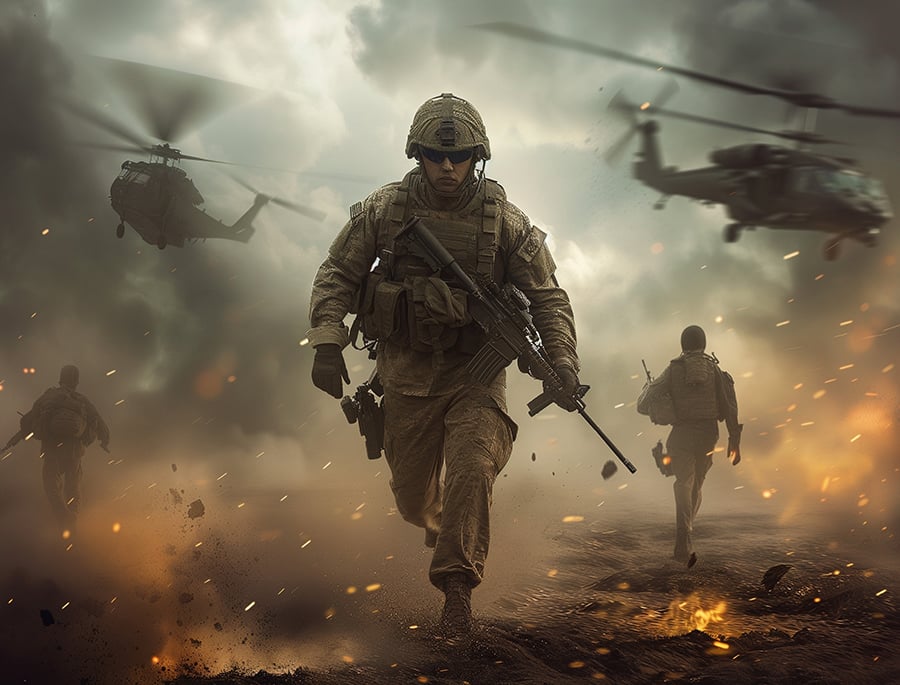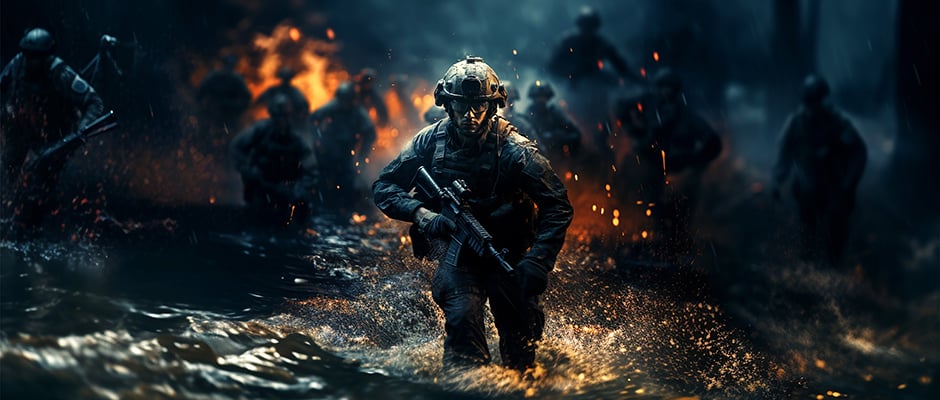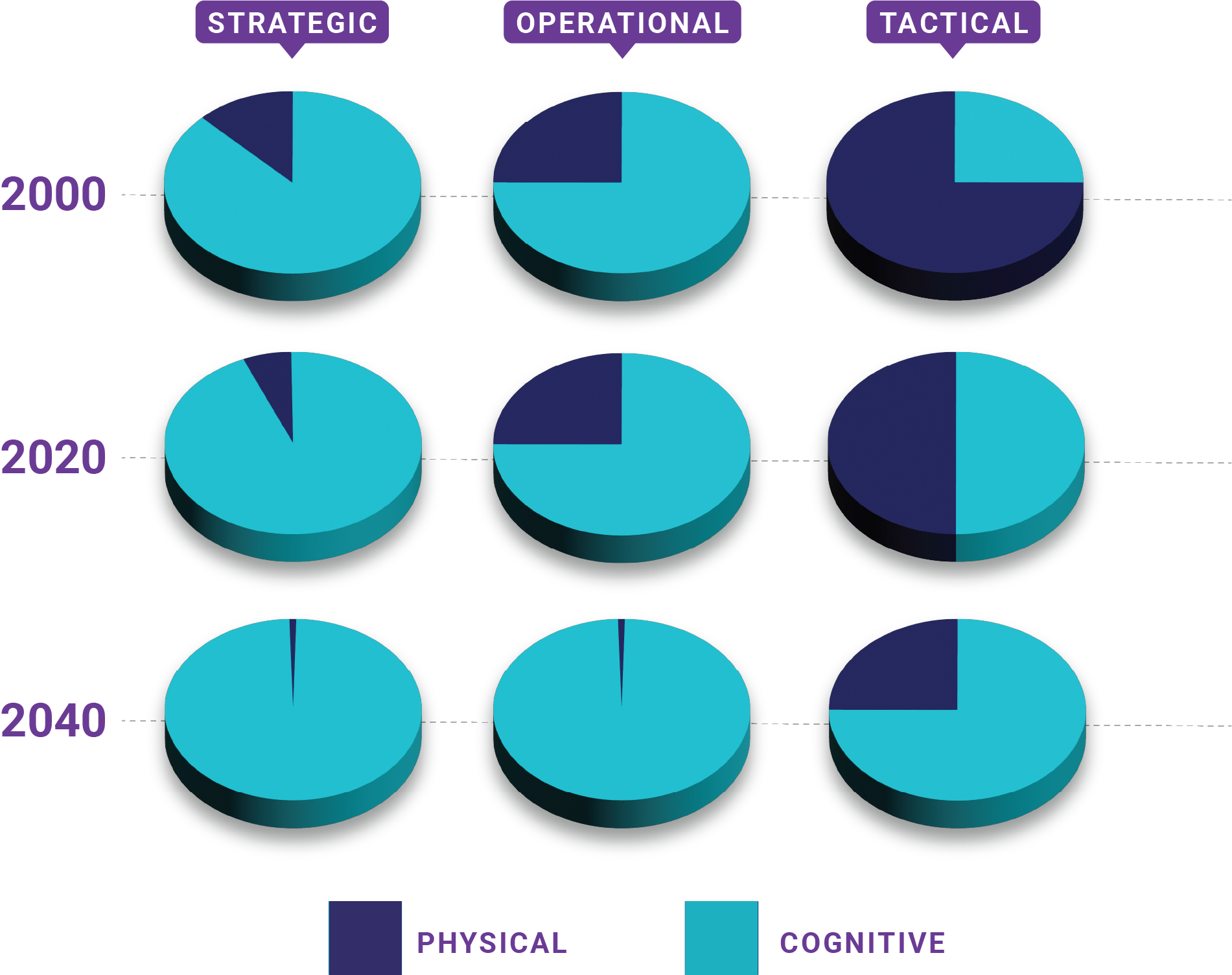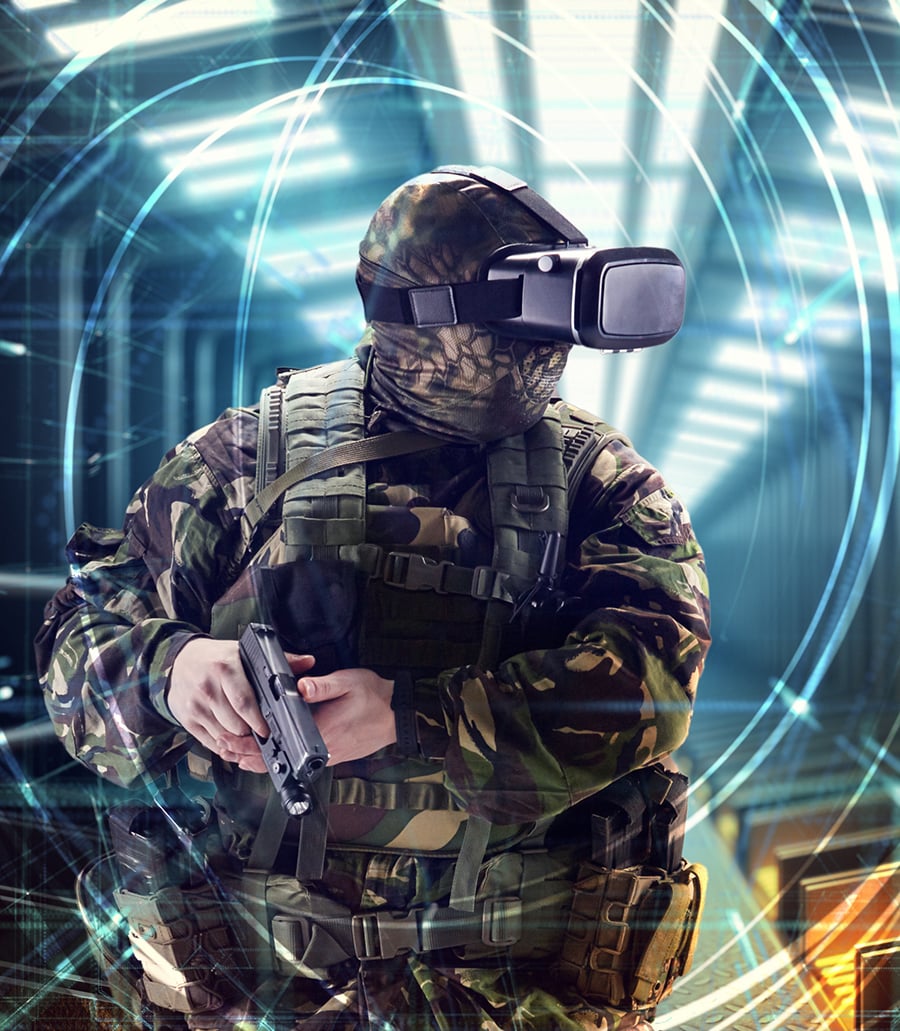Military Human Performance Technology Innovations
Preparing the Military for the Evolving Battlefield
With ongoing technological advances, what our military does today is nothing like what it did yesterday, and it won’t be anything like tomorrow. The battlefield is ever-evolving, and, according to the Army’s Chief of Staff, warfighting needs must adapt with a “continuous transformation.”
It goes without saying that how military members perform their duties is a critical factor in the success of military operations, and they can’t be viewed as isolated individuals. The human factor fits into a complex and unified whole — a group of interacting, interrelated, and interdependent components that form a system of systems (SoS).”
Although the spotlight often shines brightest on the technology components of a military SoS, humans are an integral part, and the continuous transformation of warfighting necessarily includes the continuous transformation of military human performance training.
The need for ever-evolving training has created a military simulation and virtual training market that has surpassed USD 14 billion and is projected to grow at a compound annual growth rate (CAGR) of 4.7% from 2023 to 2030.
This page will discuss military human performance through the eyes of industry, academia, small businesses, and government organizations, as well as how the Central Florida Tech Grove collaborates to grow our defense industry base, facilitates the transfer of innovative technology to Department of Defense (DOD) customers, and solves complex military training challenges.
Table Of Contents
Table of Contents
1. Understanding Military Human Performance
Military human performance refers to the physical, cognitive, emotional, and social capabilities of military personnel. It reaches far beyond basic physical fitness, from psychomotor skills to critical thinking and cognitive thought processes.
The overall preparedness of our military forces requires continuous, holistic training to ensure our service members are prepared for both current and emerging demands.

Key Components
Emerging technologies have continuously altered the battlefield landscape, thereby reshaping the core responsibilities of combat personnel. With this in mind, innovative military simulation training is now crucial for optimal human performance.
Live and on-the-job training continues in many practical applications, such as strapping on equipment, picking up weapons, and similar activities. However, these training methods come with limitations, such as an inability to utilize the powerful capabilities of our weapons systems, the potentially negative impact on entire geographical regions, and the steep cost of live iterative training.
Technology-based human performance training solutions overcome these limitations, mitigate the risk of live training exercises, and allow our forces to practice tasks that simply can’t be performed otherwise.

Benefits of DOD Human Performance Training
Innovative modeling, simulation, and training tools offer realistic opportunities for service members to navigate intense and challenging scenarios and optimize their performance.
Today, live, virtual, and constructive training, military synthetic training environments, extended reality technology, and artificial intelligence (AI) are leveraged across all branches of service to improve DOD human performance in terms of physical fitness and endurance, psychomotor skills, cognitive capabilities, and emotional resilience.
During a recent conversation with Tyson Griffin, Director of Research and Engineering for the U.S. Navy's NAWCTSD, he explained, “Over the coming years, the next ten years at least, we are going to see a huge shift to hybridized training environments that seamlessly incorporate live, virtual, and constructive components to meet training needs.”
In addition to specific job skills, current — and future — outcomes include:
- Injury prevention and risk mitigation.
- Improved problem-solving abilities.
- Reliable decision-making under pressure.
- Adaptability to changing environments.
- Refined team coordination.
2. Challenges in Military Human Performance
One of the most significant results of technological advances can be seen in the shift in the proportion of physical to cognitive demands at strategic, operational, and tactical levels.According to Billing, Fordy, Friedl, and Hasslestrom, this shift is already obvious at strategic and tactical levels and will be significant at all three levels by 2040.
According to the authors, “The disruption associated with these (innovative) technologies will most acutely be experienced by the human combatant at the tactical level, with increasing cognitive demands associated with the employment and use of new capabilities.”

Let’s take a look at the challenges military personnel and combatants face:
Operational Stress
In any workplace, stress is a contributing factor to poor performance. However, stress within a military workplace or on a battlefield — in which attention to detail is critical — can lead to catastrophic consequences.
The U.S. Marine Corps’ Simulation Training Guide states:
Well-timed and iterative simulation use allows Marines to effectively experience, rehearse, visualize, and anticipate potential outcomes of discrete friendly and enemy actions at the individual, team, unit, and staff levels.
In fact, “well-planned, designed, and executed simulation training can replicate mental stress, pose decision-making challenges, and test a Marine’s ability to respond to unexpected or new training stimuli.”
Factors contributing to stress include physical demands, cognitive overload, and psychological strain. In a ScienceDirect article, Beckner, et al., 2021 report that “80–85% of military accidents are the result of human error, stemming from fatigue and decreased cognitive performance.”
Physical Demands
Each branch of the military has its own fitness test standards, generally requiring situps, pushups, and running. Physical fitness plays a part in success in military roles, but the physical demands go beyond fitness.
While under extreme circumstances, physical task demands must still be met. Fitness combined with muscle memory developed during task repetition ensures that the body reacts appropriately and without hesitation every time.
Cognitive Load
In addition to stress and physical demands, the amount of information available to our military forces can be excessive. According to cognitive load theory, working memory is limited: cognitive overload occurs when the amount of information exceeds working memory.
Many military tasks are difficult and require personnel to process extensive amounts of information, create complex plans, and make quick decisions. When combined with operational stress, cognitive overload can lead to decreased cognitive ability, irritability and nervousness, inattention, and memory issues.
3. Military Human Performance Training Solutions
Innovative military simulation and virtual training solutions provide iterative practice for military personnel to perfect their tasks and duties in a wide variety of settings, performing physical activities under increasing challenges to build muscle memory, mitigate the effects of stress, and increase cognitive resilience.
The DOD relies on technology innovations and novel, non-traditional training solutions. At Central Florida Tech Grove, we facilitate modeling, simulation, and training advances to solve complex military human performance problems through enhanced training solutions with a focus on human factors and computer-human interaction.
There are three unique ways we help innovators solve these problems.

1. Extended Reality Technology
Extended Reality (XR) is a general term that incorporates augmented, virtual, and mixed reality; it’s designed to mirror physical surroundings to create a digital twin.
Although XR is the piece of technology most laypeople discuss when considering human performance training, it is the role of XR within the construct of systems of systems (SoS) that is critical.
The XR Tech Solution for Military Simulation Training Optimization
Today’s ever-evolving battlefield SoS includes everything from data links to satellites and soldiers to ships in the sea. All of these operational elements are interrelated, but historical training has been siloed due to non-integrated systems.
XR is essential to military human performance optimization because it addresses the challenge of placing a human being into the military SoS by allowing military personnel to wear a head-mounted display (HMD) and operate within an immersive — and connected — training environment.
In order to create that immersive and connected environment, additional emerging military human performance training technologies are needed.
2. Live, Virtual, Constructive, and Military Synthetic Training Environment Tools
A digital twin is a virtual representation of a physical object or system created with real-time data and simulation models to replicate the behavior and characteristics of its real-world counterpart. XR technologies allow someone to interact with the digital twin to practice skills and tactics in a safe, controlled, and interactive environment.
Digital replicas are used as a more flexible and cost-effective training environment while maintaining realism and providing an effective training process. They are used as training environments across various industries to monitor, analyze, and optimize the equipment, processes, infrastructure, and human performance.
In the military environment, researchers are building a comprehensive digital twin. As work progresses — predominantly for the Army — accurate digital replicas will enable military personnel to train more efficiently, identify issues before they occur, and make informed decisions. There are two key components to training in a digital environment:
Synthetic Training Environment (STE) The STE is a cohesive, integrated digital twin training environment that provides a more realistic and immersive training experience through live, virtual, and constructive training modalities.
Live, virtual, and constructive (LVC). LVC is a training framework that integrates live training deployments with virtual simulations and computer-generated, constructive scenarios to deliver comprehensive training experiences that include personnel ranging from front-line combatants to the senior echelon.
The Relationship Between STE and LVC Training for DOD Human Performance
The STE provides the infrastructure and technology necessary to create and manage live, virtual, and constructive training scenarios seamlessly. As work in the military human performance optimization field progresses, a global terrain database called One World Terrain (OWT) will simulate any location globally, providing a synthetic environment that can be accessed from anywhere in the world.
Because LVC training is managed in and by the STE, all participants will be able to access the same physical environment, training parameters, and exercise goals. In addition, the STE also incorporates a training management system to track and manage soldiers' training data.
LVC training produces so much data that it isn’t reasonable for humans to analyze it and deliver recommendations, and this is one place where AI comes in.
3. Artificial Intelligence in Military Training
AI is frequently in the press, but it is far more than a curiosity in terms of the DOD human performance training portfolio. AI, along with blockchain and cybersecurity, drives innovation and optimization within integral military training programs.
Within the ABC framework of AI, blockchain, and cybersecurity, AI serves as a foundational component that drives innovation and optimization within military training programs. It accelerates the acquisition lifecycle by increasing productivity.
The use of AI in military training applications exponentially expedites the analysis of vast amounts of data and produces preliminary reporting. It has the ability to work around the clock while meeting set standards and creating more precise writing.
Examples of AI
AI coding tools improve productivity by helping developers complete tasks 57% faster, on average, and those who used these tools were 27% more likely to complete the tasks successfully than those who didn’t, according to some studies.
AI offers interesting use cases across all fields, but it offers extraordinary benefits to high-consequence fields, such as medicine and the military.
When combined with blockchain and cybersecurity, the vision is to create a digital twin of every servicemember’s training. For example, although still in the early stages of development, TRACR Chain is a project that takes vision data from a range (Targetry Range Automated and Recording or TRACR) to track every round fired and creates an automated scorecard that is stored virtually in a blockchain.
The final vision of AI in military training will include a digital twin of every servicemember, which will provide targeted feedback and recommendations for optimized training outcomes.
Building the Future With UCF Tech Grove
Together, we can build the future.
Central Florida Tech Grove is a collaboration hub for industry, academia, and the military. As a collaborative development space, Tech Grove houses different pieces of military simulation equipment that can be used by those in industry and academia to demonstrate their innovations or continue development using those devices.
Are you ready to innovate and collaborate? See how Tech Grove can help you accelerate your technology development through our programs and events, which offer insights, education, collaboration, and connections in the military modeling, simulation, and training industry.
Have an innovation to share? Tell us about your capabilities here.
